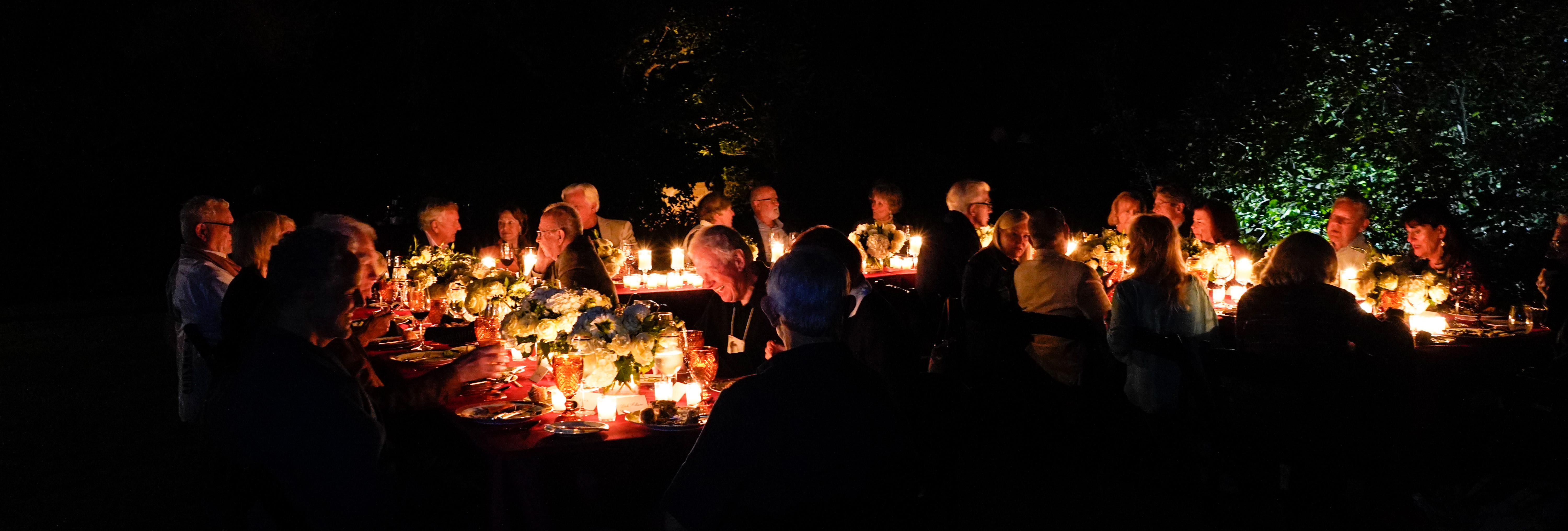DOWN MEMORY LANES: Reconnecting with Southern California Roots (September 30, 2021)
DOWN MEMORY LANES: Reconnecting with Southern California Roots (September 30, 2021)
In mid-September, Nancy and I headed south to participate in my COVID-postponed 60th high-school class reunion. While in Southern California, we took the opportunity to visit the gravesite of my parents and to rendezvous with my nephew and Nancy’s long-ago friends. Driving down and back, we tried to follow the sensible-senior-travel guidelines proposed in last month’s post. Here are some mileposts along a nostalgic excursion reconnecting past to present and youth to age.
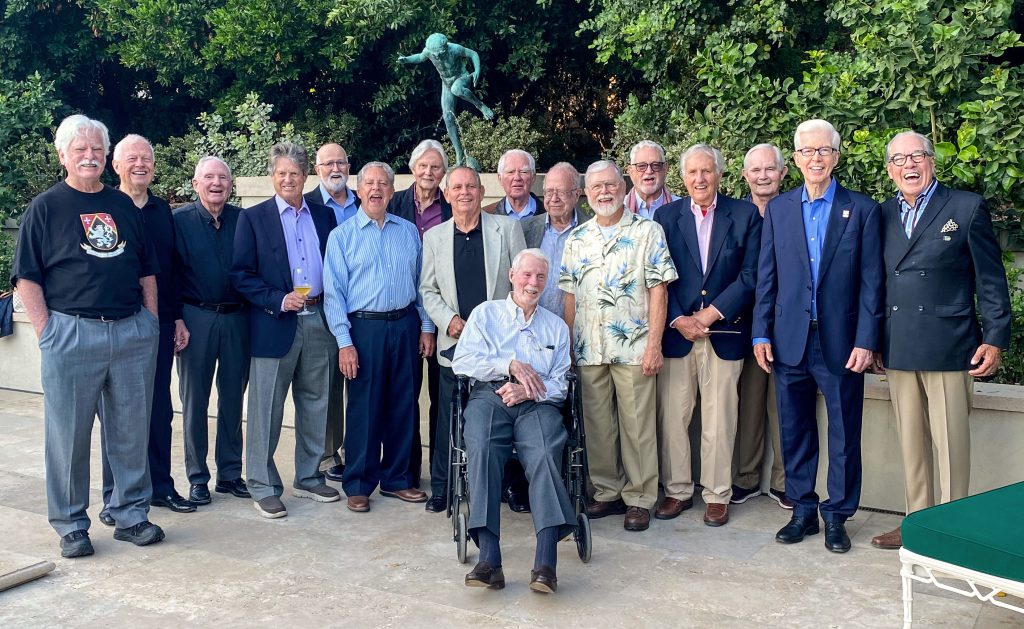
THE LAST ROUNDUP
I graduated from high school in 1960. Our class’s 60th Reunion had originally been planned for April of 2020, but COVID threw up a roadblock. During the intervening year-and-a-half until we could reschedule, two more of our members passed away. The clock was ticking. I sensed that others might be sharing my impression this was our last and best chance to get together. Seventeen alumni plus fourteen partners assembled in Pasadena, California. Six classmates came in from out of town, two more from out of state. Nearly a 50% turnout among our surviving band. To me, this signaled a tacit affirmation of enduring enthusiasm and loyalty.
Our gathering was conducted at two neighboring venues: the Huntington Library’s dramatic Chinese Garden and the beautiful home and grounds of classmate Chuck Thornton and his wife, Geneva.
Then and Now
Most Agile Aging readers may never have heard of our school, so I thought I’d introduce these reunion reflections with contrasting profiles of the institution when we were students and when we reconvened. In 1960, Harvard School was an Episcopal, boys-only, military academy, Grades 7 through 12, located on Coldwater Canyon Avenue in North Hollywood. A small-scale establishment, the school served only 300 students – 53 in our graduating class.
Fast forward to 2021 and the changes probably exceed the retentions. Now co-ed, following a merger with Westlake School in 1989, today Harvard-Westlake accommodates 1,600 students on two campuses: a Middle School in West L.A. the Upper School on Coldwater Canyon. No longer an Episcopal military academy. (No more olive-drab uniforms, M-1 rifles or close-order drill.)
Delivering an informal State-of-the-School briefing early in our reunion, HW President Rick Commons extended this timeline with an engaging historical narrative. Established in 1900 in downtown Los Angeles, Harvard School relocated to Coldwater Canyon during the Great Depression, utilizing a $25,000 loan from aviation pioneer Donald Douglas to purchase the clubhouse and two holes of the defunct Hollywood Country Club. For another $10,000, they could have had seven more fairways, stretching all the way down the hill to Ventura Boulevard. But the Trustees considered this additional debt burden extravagant. In what Rick wryly characterized as a corrective catch-up acquisition 80 years later, the School is currently finalizing purchase of nearby River Park to relieve students’ badly cramped athletic practice facilities. “A bargain” at $33 million.
Today’s school is an intense crucible of college-prep excellence. The massively expanded curriculum embraces 50 Arts courses, including theater, music and broadcasting. Its robotics and debate programs are national trophy winners. Two recent graduates competed on the U.S. water-polo team at the Tokyo Olympics. The School still emphasizes ethics and character-building, now linked with an all-hands commitment to Diversity, Equity & Inclusion. Twenty percent of the kids receive needs-based financial aid. Harvard-Westlake is often ranked as the best private secondary school on the West Coast and in the top ten nation-wide. www.hw.com.
Returning to Earth
Approaching this celebration, I felt like an astronaut re-landing at my home base after a space journey of decades. Many of my classmates had kept in touch with each other, living and working in Southern California and gathering for reunions every 10 years or so. But I had seen only two classmates in 60 years, both very recently. The rest were receding teen memories. What would they look like and sound like now? What had they been through? Who had they paired up with? What do they care about?
Astronauts or earth-bound, we usually leave our pasts behind, except for a few sustained relationships with relatives, close friends, neighbors and colleagues. More generally, then was then and now is now. We might occasionally ask, “I wonder where he or she ended up?” Or how someone turned out. Or whether they’re still alive. But these are only passing speculations, not expected to be researched or resolved. A class reunion bridges that gap, compresses the interval, affording up-close-and-personal access. I was curious and engaged.
For me, the experience offered multiple surprises, almost all of them positive. I found myself meeting not reincarnated adolescents but currently interesting elders. Mostly fat, balding survivors like myself, accompanied by animated spouses. These men were successful but mellow, comfortable in their sagging skins, with no need to strut like on-their-way-up professionals. Unrecognizable from 1960 photo-ID name tags, we made fresh connections at this party, little dependent on schoolboy recollections.
To be sure, teen escapades were resuscitated in reunion jokes, speeches and a featured slide-tape show. Football victories, revered faculty mentors, dating trepidation, even food-fights were all trotted out for energizing entertainment. But as a former solitary high-school nerd, I found myself much more attracted to present personalities and values. To my disappointment, the celebration’s crowded program did not allow much time for quiet, one-on-one reacquainting. With hindsight, this was an impractical expectation. Let’s see if we follow through on post-reunion pledges to electronically rebuild friendships from our dispersed home bases.
Close Encounters
One of the peak pleasures of this reunion was discovering unexpected paths my talented classmates had taken.
Wayne Behlendorf and I had been only casual acquaintances during our high-school days. Nancy and I were delighted to learn that Wayne had benefitted from a life-changing Peace Corps posting to Ethiopia right after college. (During that same period, Nancy was a Volunteer in Afghanistan and I’d also been selected as a Volunteer in Ethiopia before taking a different path.) Wayne taught English to 350 students, met Emperor Haile Selassie, and returned to the San Fernando Valley to pursue a vocation in secondary-school education.
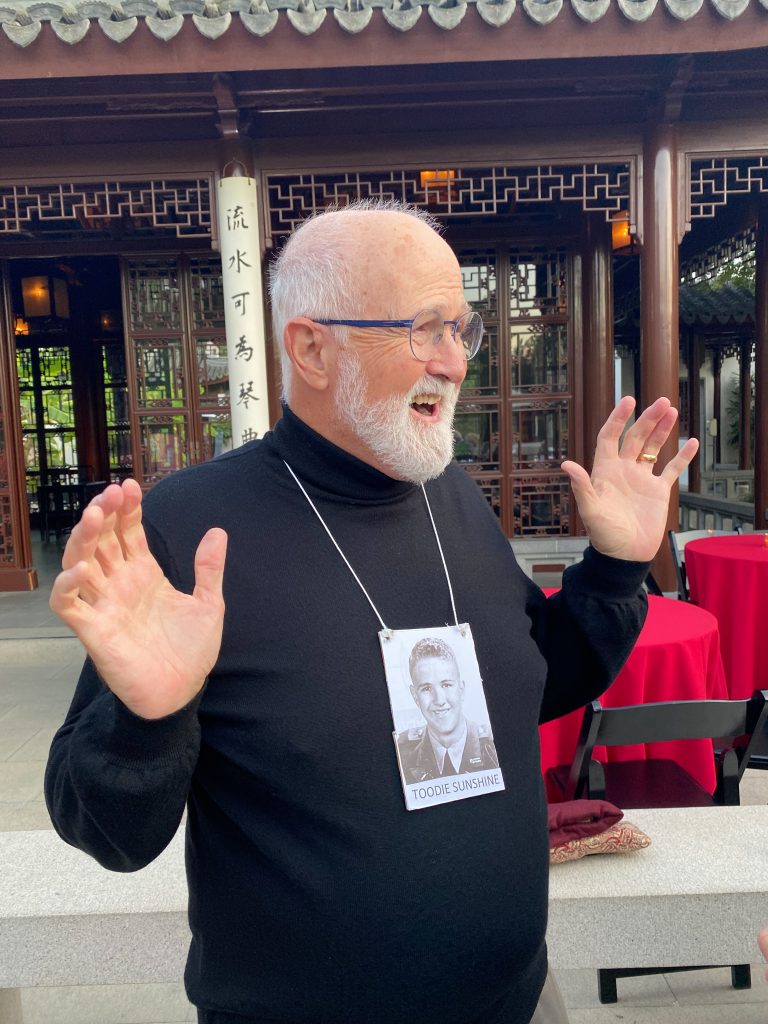
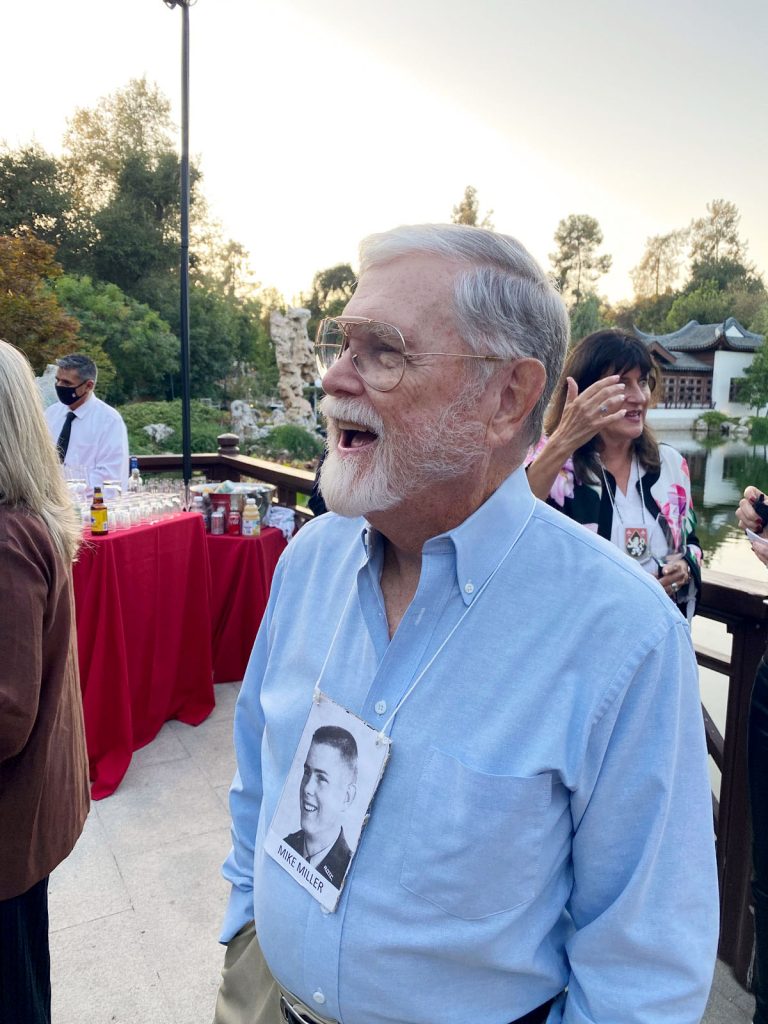
With a successful career as a commercial real-estate broker, author and trainer, combined with family obligations helping to raise four children, you’d have thought Mike Miller’s plate was more than full. But in his spare time he taught himself to play the five-string banjo and guitar, becoming proficient enough to perform professionally, backing up Linda Ronstadt and other pop legends.
Glenn Killam greeted me with an appreciative high-school anecdote about my father which I’ll share with you later in this post. I never knew this story, but Glenn hadn’t forgotten it for 60 years.
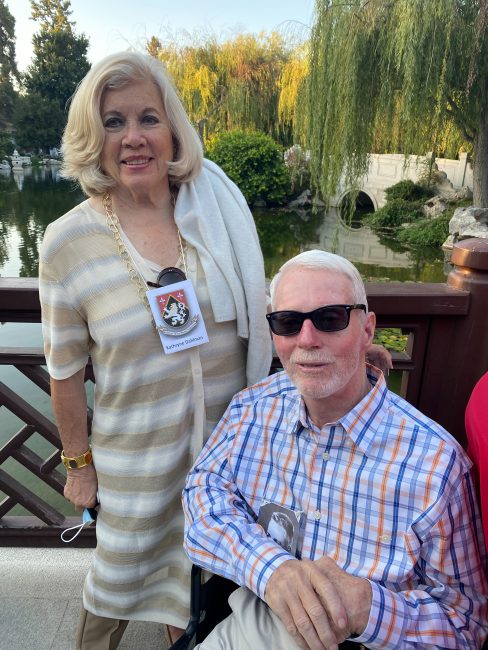 Bill Dahlman may be our bravest classmate. A lifelong competitive athlete starting in high school, he suffered a massive stroke two years ago and struggles daily to regain his balance and motor skills. (See the Dahlmans’ prior profile in the October 15, 2019 blog post.) Kathryne and Bill were key organizers of our reunion. He addressed our gathering on the program’s second evening, muscling past breath and speech impediments. His irrepressible affirmation: “I’m still Bill inside!”
Bill Dahlman may be our bravest classmate. A lifelong competitive athlete starting in high school, he suffered a massive stroke two years ago and struggles daily to regain his balance and motor skills. (See the Dahlmans’ prior profile in the October 15, 2019 blog post.) Kathryne and Bill were key organizers of our reunion. He addressed our gathering on the program’s second evening, muscling past breath and speech impediments. His irrepressible affirmation: “I’m still Bill inside!”
These being COVID days as well as a time of steady physical decline for all in our cohort, a half-dozen classmates who’d been looking forward to the reunion were forced to stay away, some cancelling at the eleventh hour. Their emailed regrets were much more than perfunctory. I was asked to read them aloud to the attendees. Larry Marks’ message blended wit with rue:
“For reasons way beyond my control and pay grade, I am here and you are there. From your perspective, you may see yourselves as being here and me there. But believe me, I’m the one who’s stuck. Somehow “there” is always where the action is. Sadly, I will not be around to assault your ears with my harmonica this evening. Wayne can tell you that a piano still has 88 keys. See you in my memories, LM”
Larry’s musical reference previewed the live session that capped the reunion gathering. A trio of classmates (ranks reduced from the intended quartet) entertained the campfire circle with notes and vocals: John Harris on guitar, Mike Miller on guitar and banjo, and Wayne Behlendorf on keyboard. John’s wife Susan joined for one Appalachian ballad to contribute additional harmony. John’s droll closing remarks struck me as a fitting coda for the reunion as a whole:
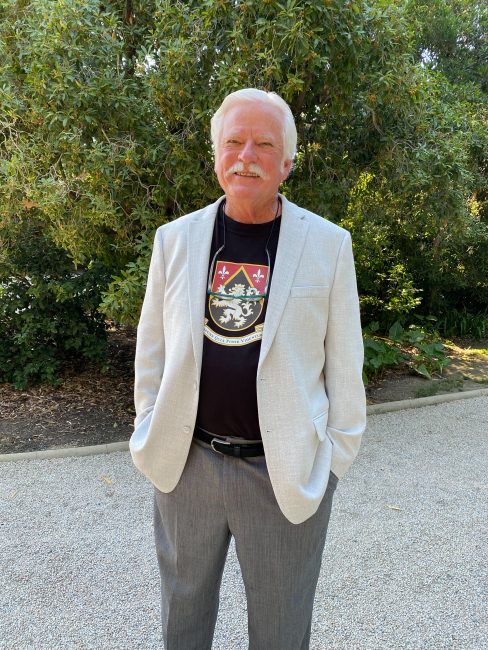 Nancy and I enjoyed a final chance encounter when we bumped into Bob and Valerie Collins at the breakfast café in our shared hotel the morning after the reunion. Bob was deservedly decompressing after two-plus years of unflagging leadership. We chatted about the gathering’s highpoints, retirement-community prospects, and the pleasure of returning home to our respective bases, in the desert and by the Bay. A welcome opportunity to stay together and say goodbye.
Nancy and I enjoyed a final chance encounter when we bumped into Bob and Valerie Collins at the breakfast café in our shared hotel the morning after the reunion. Bob was deservedly decompressing after two-plus years of unflagging leadership. We chatted about the gathering’s highpoints, retirement-community prospects, and the pleasure of returning home to our respective bases, in the desert and by the Bay. A welcome opportunity to stay together and say goodbye.
FAMILY TIES
On Saturday morning we drove to Forest Lawn in Glendale to pay our respects to my late parents, a repeated ritual whenever we found ourselves in Southern California. Neighborhood florists seemed all COVID-closed, but we finally procured a flourishing pot of burgundy mums.
I’ve always liked the small walled enclosure in which my folks are buried, an oasis of serenity within the sprawling complex. Their graves are side-by-side, somehow fitting for spouses born in the same year (1906) and dying within weeks of each other (1989.) Mom’s immigrant parents are buried short strides away.
Ours was a nurturing family during my entire childhood and adolescence. As a middle child five years apart from each of my brothers, I wasn’t particularly close to my siblings, but our household was comforting and comfortable. Drama and conflict never entered in. Reflecting on a bench near my parents’ grave, I remembered how I’d under-appreciated my folks when I was growing up. I loved them both, for sure. But especially as a teen, I tended to take them for granted, judging them “normal” and “ordinary,” not ringing endorsements in my expanding vocabulary. In my innocence and ignorance, I assumed that all couples were happily married, all families secure.
Emerging from my adolescent shelter into adulthood, I came to reassess and respect my parents as literally exceptional. Both had arrived in California in their early twenties: he, from St. Louis to seek his fortune in the accelerating produce industry; she, accompanying her British parents via Canada to take up residence in L.A.’s expat community. After marriage in 1933, both soon formed successful small businesses while starting to raise a family. During and after the Depression, they contributed financial support to Dad’s parents and seven siblings and to Mom’s parents and sister. They put their three sons through private secondary school and universities. Both were active in the community: Dad in the Masons and on the Boards of the Boy Scouts and Harvard School; Mom at St. James Episcopal Church and in hospital auxiliaries. They quietly expected their kids to do well in school but were never demanding or dominating. It’s taken me far too long, but I now credit my parents with inspiring my optimism and career commitment to public service. Surrounded by Hollywood celebrities in the Harvard School environment, my folks were low-key but high-value.
Tying life threads together, at the reunion I learned of one occasion when my father had demonstrated his character and leadership style. Classmate Glenn Killam shared an encounter that had stayed with him over the decades. As Editor of our class yearbook, Glenn had a vision of commissioning an aerial photo of our Coldwater Canyon campus. In that pre-drone era, this meant hiring a helicopter. Receiving no support from his faculty mentor, Glenn got up his courage and reached out to my dad, then President of the school Fathers Club. Dad invited Glenn to make a presentation at the Club’s upcoming meeting. At that session, he saluted Glenn’s moxie and encouraged the circle to mobilize their contacts and resources. One day later, Glenn had his helicopter.
***
The day after the reunion, Nancy and I were pleased to rendezvous with my nephew Thom and his partner Jay, over lunch in Old Pasadena. Thom is the son of my late older brother Bob. During Bob’s difficult decline into dementia, Thom and I had grown close as I commuted quarterly to Orange County to spend quality time with my brother and assist with his care. More recently, Nancy and I had supported Thom through a wrenching personal transition.
These are happier times. Thom’s excited about his new mortgage-protection insurance practice, having just obtained his California license. Jay’s financial-services career is going so well that he’s contemplating establishing a philanthropic fund for impoverished children, remembering his own disadvantaged origins. Texts, emails and phone calls keep communication channels open. But face-to-face sharing is special when we live far apart.
NANCY’S REUNION
I wasn’t the only member of our family utilizing this expedition to refresh old ties. En route to Pasadena, we enjoyed a warm get-together with John and Carmel Whitman in Ojai. John and Nancy had been young colleagues at CBS in L.A. in the Sixties. John and Carmel now divide their time between Ventura, California and Haarlem in the Netherlands, where their daughter and son-in-law are raising a family. We caught up on their travel schedule, compared notes on fast-morphing Ojai, and shared concerns about national affairs. Even with only a few hours together, it was exhilarating to find so much common ground for strengthening this friendship going forward.
ROAD NOTES
Cruising down and back to Southern California, Nancy and I continued to follow the sensible-senior-road-travel guidelines proposed in my August 31 blog post. Restricting our daily driving time to four hours plus breaks, we broke our journey with two overnight layovers outbound and one returning. Reducing freeway stress in favor of scenic byways, we made the travelling a core contributor to trip satisfaction. A special treat was our inland route from San Luis Obispo to Ojai: CA166 through dramatic canyons, then CA33 through deserted Los Padres National Forest, up and over Pine Mountain.
One unavoidable feature of these cross-country landscapes was their bone-dry aridity. Despite dozens of signs naming rivers, creeks and lakes, in multiple days and hundreds of miles we passed only two small ponds with visible water. Tree crops were suffering. Irrigated vineyards testified to California’s intensifying water wars. The late-summer season explained part of this drought, but climate change is clearly transforming the terrain.
Indulging ourselves with distinctive accommodations, we greatly enjoyed Ojai’s Emerald Iguana Inn (www.emeraldiguana.com) and the Langham Huntington Hotel in Pasadena (www.langhamhotels.com/pasadena.) The two properties’ contrasts were stimulating. The 13-room Inn is a charming pueblo-style complex accented by handsome plantings, all tucked inconspicuously into a residential cul-de-sac. A labor of love, it was designed and decorated by local architect and artist Marc Whitman and his wife Julia. The 380-room Langham is a hundred-year-old landmark on 23 terraced acres, reconstructed and restored to its former glory in 1991. Five stars from top to bottom, its staff went out of their way to make us welcome.
On our way out of L.A., Nancy plotted a surface-streets meander. From posh San Marino, we traversed South Pasadena, Glendale, Toluca Lake and San Fernando. I relished the dozens of ethnic neighborhoods and the glimpses of bungalows surviving from my receding childhood. We estimated that the avoidance of metropolitan freeways had cost us 30 minutes. What a cheap price for a basket of memories.
HOME THOUGHTS
Back home at my laptop, our Memory Lanes excursion has got me thinking about time, its pace and its phases. I’m intrigued, for example, by time’s twisty subjectivity. In my twenties and thirties, I recall observing blue-blazered elders shuffling back to Yale for their 60th reunions, cheekily wondering if they’d make it through the front gate. Now in three short years, that hobbler will be me. Same continuum, different perspective.
And identical time spans can have dramatically different lengths. The 60-year stretch since our high-school graduation seems long but familiar, just tweaked by reunion handshakes and archival photos. But pivot that same interval to the 60 years before our graduation. Whoa! We’re in 1900! Before Teddy Roosevelt entered the White House and the Wright Brothers lifted off the ground. Ancient history! Can these durations truly be equivalent?
Listening to President Commons’ recitation of Harvard-Westlake’s dramatic evolution, I was amused by past property conversions and curious about COVID’s present impact on students’ learning progress. But I find I’m most interested in the School’s future. Elite institutions are under constant attack these days, with some justification. Yet I still believe there’s a legitimate – indeed essential – need for centers of excellence to nurture future leaders. With Diversity, Equity and Inclusion, to be sure. But also dedicated to encouraging open-mindedness, self-discipline and diligence. I earnestly hope our school survives and succeeds.
More personally and selfishly, the present increasingly commands my priority attention. I do love learning about history, modern as well as ancient, revisionist as well as established. And I’m keenly concerned about future challenges, local, national and global. But as the hour-glass grains seem to drop at an increasing pace, each remaining day somehow counts for more. I’ve no desire to be young again; TV advertisers can save their breath. What I want to study and practice is agile aging. How to be a better person today. Reducing my ignorance, impatience and irritability. Increasing my maturity, equanimity and compassion. So much to learn, so little time.
These reunions have been a refreshing intermission. I’m ready to get on with the last act.
With sincere thanks to my Harvard School classmate Tom O’Neal and his wife Mollie for kind permission to reproduce their reunion photographs. www.tgophoto@gmail.com.
Coming October 31: TAKING THE RIGHT TURN
[Blog readers share fortuitous life choices.]
Let me hear from you: rbs@agileaging.net
